Sugarloaf (ski resort)
| SUGARLOAF | |
|---|---|
 | |
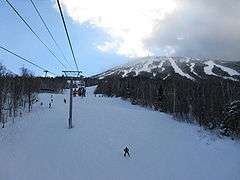 View of Sugarloaf from the Whiffletree SuperQuad | |
| Location |
Carrabassett Valley, Franklin County, Maine |
| Nearest city | Farmington |
| Coordinates | 45°01′53″N 70°18′47″W / 45.03139°N 70.31306°W |
| Vertical | 2820 ft (859 m) |
| Top elevation | 4237 ft (1291 m) |
| Base elevation | 1417 ft (432 m) |
| Skiable area | 1,230 acres (500 ha) |
| Runs | 160 |
| Longest run | 3.5 mi (5.6 km) |
| Lift system | 14 |
| Lift capacity | 21,810 Skiers per hour |
| Terrain parks | 3 (+ Superpipe) |
| Snowfall | 197 in. (10 year average) |
| Snowmaking | 95% |
| Night skiing | No |
| Website | Sugarloaf.com |
Sugarloaf (formerly Sugarloaf/USA) is a ski area and resort located on Sugarloaf Mountain in Carrabassett Valley, western Maine. It is the second largest ski resort east of the Mississippi in terms of skiable area (1,230 acres or 500 ha after Killington's 1,509 acres or 611 ha)[1][2] and snowmaking percentage (95%); its continuous vertical drop of 2,820 feet (860 m) is the second longest in New England (after Killington's 3,050 feet (930 m)).[3] Sugarloaf recorded a total of 352,000 skier visits in the 2005–2006 season, ranking it second among Maine resorts and 11th in New England, according to Ski Area Management magazine.[4][5][6][7]
At 4,237 feet (1291 m) Sugarloaf Mountain is second in elevation to Maine's highest peak, Mount Katahdin. The summit of Sugarloaf offers the only lift-serviced above-treeline skiing in the Northeast.[6] The Appalachian Trail crosses within 0.6 miles (0.97 km) of Sugarloaf's peak and the summit offers 360 degree views of Maine's western mountains and New Hampshire's White Mountains.[8]
As of March 2010, there were 54 miles (87 km) of marked trails and a total of 651 acres (263 ha) of developed trails. There were 1,400 acres (570 ha) of skiable area boundary to boundary. The fifteen chairlifts have the capacity to carry 21,180 skiers per hour. There are also 154 marked trails and glades, most of which are named after logging terms in a tribute to Maine's logging history. Trails include thirty-four rated as green circle (25%), forty-four blue square (32%,), thirty-nine black diamond (28%), and twenty-one rated double black diamond (15%). There are also twenty glades (13%), and three terrain parks. Lifts include two SuperQuads, 3 high-capacity quads, five doubles, one triple, one T-bar, and one carpet surface lift. The Sugarloaf season runs from mid-November through early May.[6][9]
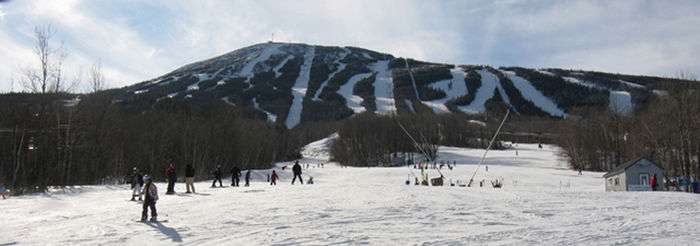
History
The Beginnings: 1950–1960
The first trail was cut at Sugarloaf in 1950 by the Sugarloaf Mountain Ski Club and a group of locals known as "The Bigelow Boys". Led by Amos Winter, along with Stub Taylor, they transformed the mountain into what is today one of the largest ski areas in the Northeast. The founding of the mountain was called for by the US ski association. Thy hired Pheous Sprague to find a mountain in Maine. Initially, they planned to have the mountain on the Bigelow mountain range, but when flagstaff lake was made the plans had to be scrapped. Phin Sprague then found Amos and Stub which knew of a mountain called Sugarloaf. Many documents relating to the founding and early years now reside at the Ski Museum of Maine in Kingfield, Maine.[10]
In the summer of 1950 Sugarloaf Mountain Ski Club was formed and club member Amos Winter and many volunteers helped cut the first trail up Sugarloaf Mountain, appropriately named Winter's Way. It wound down the Mountain with a 1,800 vertical foot drop and was cut in many places across the hill. Amos noted later that this trail was flawed in its design.[10] In 1952, the first of many ski races was held on Winter's Way.
In 1953 a 700 ft (210 m) rope tow was installed up the lower part of Winter's Way, which was a gentle slope and could be used by beginners and intermediates, while it helped take a few steps out of the hike for experts.[10]
In the summer of 1955 the ski club issued stock and formed the Sugarloaf Mountain Corporation and the first T-Bar was installed. It ascended some 900 vertical feet from the base (a warming hut) and was capable of carrying some 600 skiers per hour. The Narrow Gauge trail was cut to skiers' left and Sluice to skiers' right.[10]
A year later in the summer of 1956 another Constam T-Bar was purchased and installed. This T-Bar ran from the top of the first T-bar up into the snowfields another 2,600 ft (790 m) away (This T-bar is in the same place as the current #3 T-bar is today, and the first T-bar was in the place of current "Long Side" or Double Runner West).[10]
In the summer of 1959 the base area was relocated some 250 feet (76 m) down the hill. A two-story lodge was built and another T-bar added to service the beginner area.[10]
Sugarloaf/USA 1960–1971
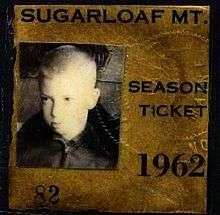
During the summer of 1961 the #4 and #5 T-bars were installed on the east side of the mountain. They opened up the area that is now called Whiffletree and King Pine Bowl. As of late 1961 electricity only went as far south as Sugarloaf (from the south through Rangeley via Rangeley Power Company Lines west to Eustis, and then south into Carrabassett Valley). The efforts of Leo Tague, a motel owner, brought power to the valley in the beginning of that winter.[10]
During the summer of 1964 it was decided to install a lift made by Polig-Heckel-Bleichert. In the summer of 1965, Sugarloaf installed "The Mighty Gondola", a four-passenger PHB, 8,430 ft (2,570 m) aerial lift, rising convert 2350 vertical feet to the top of Sugarloaf Mountain.[10]
In the summer of 1969 the first chairlift was installed to the west of Tote Road. The chairlift, Bucksaw (which was taken down in 2015), carried 945 passengers per hour up 1,200 vertical feet and over a mile. It opened up new intermediate terrain referred to now as West Mountain.
The second chairlift was installed in 1970 when Sugarloaf Mountain Corporation (SMC) bought the Sugarloaf Inn. This lift, Sawduster, was installed to carry passengers from the Inn to the Base Lodge.[10]
The Tall Timber Classic is an alpine race course held on Sugarloaf's Narrow Gauge Trail. It has hosted the World Cup (1971) and three U.S. Nationals (1996) (2006) (2008) events, along with many other Downhills and Super-G's. Statistics for the Tall timber classic include a men's downhill vertical drop of 2,430 feet (740 m) and length of 8,220 feet (2,510 m); a women's downhill vertical drop of 1,957 feet (596 m) and length of 6,850 feet (2,090 m); a men's giant slalom vertical drop of 1,347 feet (411 m) and length of 4,830 feet (1,470 m); and a women's giant slalom vertical drop of 1,347 feet (411 m) and length of 4,830 feet (1,470 m).[10]
Growth and expansion: the 1970’s
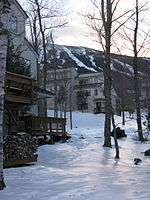
During the early 1970s there was a lack of snowfall throughout the Northeast. This event and the 1967 Oil Embargo a few years earlier would set Sugarloaf on a path towards bankruptcy a decade later. This lack of snowfall did have some positive effects however - snowmaking was installed. In 1973 Sugarloaf was unable to make any snow for December. Saddleback, located in nearby Rangeley, Maine did however have snowmaking (it was limited to the Wheeler Slope).[10]
On October 26, 1971, the residents of then Jerusalem Township voted 21–13 to incorporate and create the town of Carrabassett Valley, Maine. The first town meeting was held the next year on April 26, 1972. Crocker and Wyman Townships declined to join Jerusalem township at first, but Crocker township joined the next year. The town would play a huge role in the development of Sugarloaf/USA and the nearby Sugarloaf Outdoors Center.[10]
Valley Crossing was built by the Airport, where the Fire Station, Town Hall, and many other local government and private buildings are located. The Valley Crossing Complex included ski shops, restaurants, condos, and commercial shops. Due to its location, however, the entire Complex was moved up to the base of Sugarloaf.
In the summer of 1972 WTOS-FM "The Mountain of Pure Rock" radio station out of Skowhegan, Maine began transmitting from a radio tower perched on the top of Sugarloaf Mountain.[10]
In the summer of 1973 two more lifts were installed, Double Runner East and West. They replaced the #2 T-Bar and were extended down further to be closer to the base lodge. They were both Borvig Double Chairs. They both had an uphill capacity of about 1,200 passenger per hour, and the two lifts are 4,000 ft (1,200 m) and 3,100 ft (940 m). These lifts are both still in use today.
Because of the lack of snow for the 1973-74 season, SMC decided to install snowmaking. The first trail to have snowmaking installed was Narrow Gauge, where it was installed top to bottom.
That same summer the Spillway Chairs were installed. Spillway East, rated one of New England's best double chairs, stretched about 4,020 feet (1,230 m) long with a vertical rise of 1,500 ft (460 m), and could carry about 1,200 passengers per hour. The #3 T-Bar is still in operation today, and operates on busy days and when wind is too strong to allow for the Spillway Chairs to run.[10]
With all the new real estate development and an increase in skier days, the power supply was becoming a problem. This changed however in 1975 when Rangeley Power Company was purchased by Central Maine Power (CMP). CMP built a new transmission line from the Wyman Hydro Dam in Moscow, Maine. Additionally, Carrabassett Valley annexed Sugarloaf Township (formerly Crocker Township).[10]
Mountainside Corporation and the Appalachian Trail
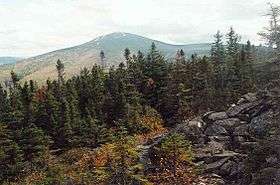
Several important developments occurred in the late 1970s. On June 25, 1976 Mountainside Corporation was created to take charge of developing and marketing real estate development on Sugarloaf. Mountainside sold the Sugarloaf Inn to Peter Weber. Mountainside is responsible for the condos built along Buckboard off Whiffletree, and many other projects important to Sugarloaf's growth.[10]
During this summer, the Appalachian Trail was moved from the summit of Sugarloaf, to over the summit of Crocker Mountain. In 1978 a fleet of Pisten Bullies was purchased for grooming; this became necessary because of the lack of natural snow. Larry Warren, appointed President in spring of 1979, negotiated the purchase of 1,170 acres (4.7 km2) of land on the adjoining, Burnt Mountain, for future lift and trail development. At the end of the 1970s Sugarloaf/USA had an uphill capacity of more than 9,000 skiers per hour.[10]
The 1980s and 90s
With the help of Peter Weber, a golf course, designed by Robert Trent Jones Jr, was constructed at the resort. At the same time, the Carrabassett Valley Academy was also founded. The cost of building new real estate and overruns, along with the lack of natural snow and snowmaking, put SMC in debt.[10]
In the year 2000, Sugarloaf/USA officially celebrated its 50th anniversary. The celebrations included a new color scheme which included orange, introduced for the year. In just fifty years Sugarloaf had moved from a mountain with just one trail, to one with over one-hundred-and-thirty trails, fourteen lifts, and had hosted World Cups, U.S. Nationals, and many other ski and snowboard events (Pictured is the Sugarloaf Logo with the orange scheme).[11]
New ownership: 2007–Present
In August 2007 Sugarloaf was sold by American Skiing Company to CNL Lifestyle Properties, to be managed by Boyne USA Resorts. CNL/Boyne also purchased Sunday River, another Maine ski area owned by ASC.[12]
Under new management, the resort promptly began performing overdue maintenance and upkeep that had begun to be neglected during lean ASC years. This included dismantling the old Gondola mid-station building, re-painting and maintaining lifts, towers, and buildings that were showing signs of neglect, and making significant upgrades to the resort's snowmaking system.[13] Boyne USA Resorts also removed the "USA" from "Sugarloaf/USA."[12] Boyne also installed the Moosecalator, a Magic Carpet, on The Birches Slope.
During the Summer of 2008, Sugarloaf saw more than $5 million in offseason upgrades, including all new pumps for the snowmaking system, 25 new Boyne Low-E fan guns, and 50 low energy HKD tower guns. The resort also installed all new trail signage, replaced old, run-down lift shacks with new lift building, and completely redesigned its Terrain Parks, including a new snowboardcross course designed by Olympian Seth Wescott. The resort also saw a significant expansion to its on-mountain restaurant, Bullwinkle's.[14]
In the fall of 2009, Sugarloaf and Boyne, with the help of Olympic gold medalist Seth Wescott are trying to team up with the town to help purchase a new "signature lift". Seth Wescott presented a proposal during a town meeting to see if the town would help finance for a new $10 million gondola that would run the same path as the original gondola.
| Wikinews has related news: Over 200 skiers trapped as lift breaks at Maine resort |
It was announced that in the summer of 2011 a new fixed grip quad chairlift would replace the aged Spillway lift. That work was completed and the Skyline lift, a $3 million Doppelmayr carpet-loading fixed-grip quad chair, opened during the 2011-12 season. Also for the 2011 ski season cutting began on phase two of the Burnt Mountain Expansion and the Drive system in the SuperQuad was upgraded from analog to digital.[15]
In recent seasons, cutting has continued under the Burnt Mountain project, extending accessible terrain beyond Brackett Basin to the summit of Burnt Mountain and portions of the Eastern Territory.[16] During the 2015-16 season, a new Doppelmayr terminal was installed at the King Pine lift and the Bucksaw lift that had long served the West Mountain area was taken off-line and dismantled.[17]
In 2016, CNL sold its ski resorts; Sugarloaf was sold to Och-Ziff Capital Management.[18]
Boyne's plans going forward are outlined in its Sugarloaf 2020 postings and updated from time to time as developments dictate. Among Boyne's goals in coming years is expansion of snow-making with Caribou Pond as a new water source.[19] Boyne purchased the resort from Och-Ziff Capital Management in March 2018.
Accidents
On December 28, 2010 the Spillway East double chair derailed, sending some passengers on a 30-foot (9.1 m) fall.[20] The accident injured 8 people and was blamed on a misaligned cable.[21] At least one lawsuit against Sugarloaf was filed in regards to the incident.[22]
On March 21, 2015 the King Pine quad chair experienced a rollback, seriously injuring 7 skiers, including 3 children, when chairlift malfunctions. Four taken to the hospital.[23]
Summer activities
Sugarloaf offers many on-mountain summer activities such as golf, hiking, mountain biking, ziplines, and court sports such as tennis and basketball.
Public transportation
The Sugarloaf Explorer is a free public transportation system that services the resort. It features eight bus routes linking residential neighborhoods, condominiums, inns, and hotels in Carrabassett Valley with the Sugarloaf Base Lodge, the Outdoor Center, and local shops and restaurants.[24]
There are no regular service coach buses, commercial airline flights, or rail service to the mountain. The closest bus service is Augusta (80 miles), which is served by Greyhound Lines and Concord Coach Lines. The closet commercial airline service is also Augusta, which is only served by Cape Air. However, Portland International Jetport in Portland (134 miles) is served by eight different airlines, including low-cost carriers such as JetBlue and AirTran Airways. Amtrak also serves Portland, with five round-trip trains daily on the Downeaster.[25][26][27][28]
Mascots
Sugarloaf is home to three mascots: Amos the Moose, Blueberry the Bear and Pierre the Lumberjack. Amos' cabin is accessible off of the Moose Alley trail.[29]
References
- ↑ http://www.killington.com/site/mountain/mountain-info/mountain_stats
- ↑ http://www.sugarloaf.com/the-mountain
- ↑ http://verticalfeet.com/
- ↑ Ski Area Management magazine
- ↑ Ski Maine Association.
- 1 2 3 Sugarloaf Mountain stats.
- ↑ SAM News Archives.
- ↑ National Park Service, comp. "Appalachian Trail." Map.
- ↑ logging terms
- 1 2 3 4 5 6 7 8 9 10 11 12 13 14 15 16 17 18 Christie, John. The Story of Sugarloaf. Camden, Maine: Down East Books, 2007.
- ↑ Portland Press Herald Online.
- 1 2 Boyne (Press Release)
- ↑ Sugarloaf (Press Release)
- ↑ Sugarloaf (Press Release)
- ↑ "Sugarloaf | 2020". sugarloaf2020.com. Retrieved 2016-04-28.
- ↑ "Sugarloaf | 2020". sugarloaf2020.com. Retrieved 2016-04-28.
- ↑ "Sugarloaf | 2020". sugarloaf2020.com. Retrieved 2016-04-28.
- ↑ "No big changes expected with new owners at Crested Butte Mountain Resort". The Denver Post. 2016-11-08. Retrieved 2017-12-05.
- ↑ "Sugarloaf | 2020". sugarloaf2020.com. Retrieved 2016-04-28.
- ↑ "Ski lift malfunction injures 9 at Maine resort". CNN. 28 December 2010. Retrieved 28 December 2010.
- ↑ "Misaligned Cable Blamed for Sugarloaf Chairlift Accident". New York TimesN. 29 December 2010. Retrieved 29 December 2010.
- ↑ "Suit against Sugarloaf gets go-ahead". Portland Press Hearld. 11 June 2014. Retrieved 11 June 2014.
- ↑
- ↑ Sugarloaf Explorer
- ↑ Grayhound Routes
- ↑ U.S. Airways Routes
- ↑ Portland International Jetport
- ↑ Amtrak Downeaster
- ↑ http://www.familyskitrips.com/family/ski_resort_mascots.htm
External links
![]()
- Sugarloaf.com - Official Sugarloaf homepage
- SugarloafToday.com - The Unofficial Sugarloaf Chat on Sugarloaf Today.